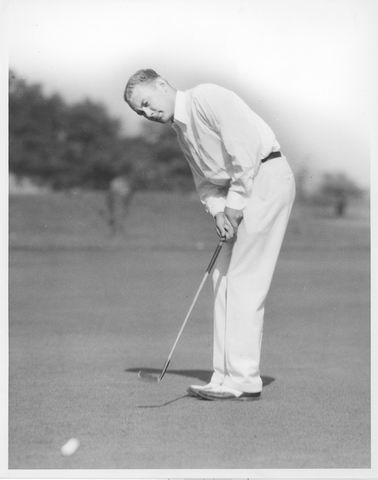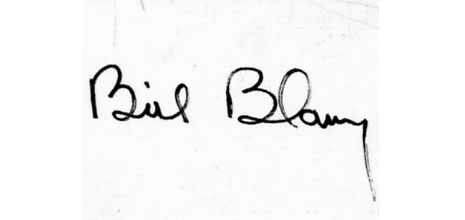|

Comments on History of USGA Handicap Procedures
by William O. Blaney (former USGA Handicap Chairman 50 years ago)
written July 15, 1980
As you may or may not know, I am, and always have been, an advocate of the basic-ability system of handicapping (best 10 of the last 50 scores), a fact that will be most evident in my following comments. I feel basic-ability is much more representative of golf as it has been, and should be, played. I also feel it is less subject to manipulation by those who seem to desire a handicap advantage. But I won't go so far as to say that I approve of the Calkin's System (best three scores over a long period of time). Any handicap system should give relief from a player's potential to retrogress via age, injury or other physical disability. But I do not think such relief should be granted because of infrequent play, refusal to practice, and other factors within his control.
Dismissal of McMahon. I did not dismiss Tom. At a time when the USGA wanted to know who should be on the next Handicap Committee, I made the remark that Tom seemed to have outlived his usefulness because he would not agree to any alternative or compromise away from his beloved current-ability system (best ten of the last 15) which he had devised for the Chicago District Golf Association and later took with him when he moved to California (at that time the system was known as the "McMahon Handicap System"). As a result he was not reappointed to the committee, a majority of which felt a basic-ability system was more in line with its needs.
Best 10 of the last 25 differentials. The adoption of the best 10 of the last 25 differential method occurred while I still headed the Handicap Committee. It was, as indicated in HISTORY, intended to be a compromise between the 10/15 current and 10/50 basic ability concepts. It was not a concession that the current-ability system "had some merit." This compromise was flatly turned down by McMahon.
Handicaps for stroke play, match play or both. It is hard to believe a single handicap system can be used equitably for both stroke and match play, especially when stroke controls are involved. Hole scores of more than two or three over par are not uncommon. If these are "controlled" out of the scores of any player who may average one or two of them a round, the resulting handicap would not be a representative one in stroke play competition. On the other hand, if they are not "controlled," the resulting handicap would give said player an unfair advantage in match play. Of course if any easy way could be found for players to report both "uncontrolled" and "controlled" scores for each round, I am sure the computer could produce both "stroke" and "match play" handicaps. But could all golfers be educated to correctly report such a dual system?
Another thought on the subject. It is my belief that the vast majority of scores used in determining handicaps are those made when players are competing in match play. When four individuals start out from the first tee, it is commonplace for them to have paired off in sides and arranged to compete against each other at match play for some sort of monetary or other considerations. Under such an arrangement the completion of every hole by each player according to strict stroke play rules is rarely, if ever, accomplished. Each player is intent on helping his side win as many holes as possible, so some chances are taken (with good or bad results), putts are charged (with like results), and when each hole has been decided partners either pick up their balls or halfheartedly putt out. In the latter case one can usually tell if the individual is a "burgler" when he invariably misses those putts, regardless of their length. That aside, what we may now consider a stroke play handicap may in reality be a match play handicap.
A truer match play handicap may be obtained by use of the "Point System." Under this, points are awarded for each hole as follows:
| Double bogey or higher |
0 |
| Bogey |
1 |
| Par |
2 |
| Birdie |
3 |
| Eagle |
4 |
| Double Eagle |
5 |
The points for each player are totalled for the 18 holes, with said total then being deducted from 36. The result will show each player's match play ability for that particular round. In other words, the result would be the player's match play handicap for that round. If we could obtain a player's handicap for 20 rounds and average the lowest 10, said average would be a most useful match play handicap for future use (or until subsequent computations authorized a change). The "portability" of such a handicap might be questionable, but if it could be adjusted up or down by the difference between the ratings of the course involved, it might be acceptable.
Differentials. I endorse the use of Tom McMahon's "differentials" between scores and course ratings, as it provides the needed "portability of handicaps." The British go (or used to go) a step farther by having a table to adjust handicaps of players whose home course is long and difficult when they play a shorter and easier course-- and vice versa. It might be worthwhile checking into this to see if it might help the portability problem.
Equitable Stroke Control. This is more necessary for current-ability handicaps than for basic-ability. In the latter case, a differential from a score with a number of bad holes probably would be less likely to be among the player's "best ten." Stroke control now seems to be well understood by, and have a moral effect on, the majority of present-day players. I see no objection to continuing it -- provided all players use it.
85% of stroke play handicap in match play. The 1947 recommendation to use 85% of handicap in match play was an attempt to make that form of play more equitable for all concerned, as use of the full difference seemed to favor the higher handicapped players.
80% of 10 best differentials plus one. The use of 80% plus one for singles handicaps was not done for "computational simplicity," and it was not as illogical as some have thought, even though it gave a 1 handicap to a golfer whose average differential was zero. In singles match play using the full difference in handicaps, the number of strokes given (or received) under the 80% plus one formula is identical to the number of strokes given (or received) under the 80% plus zero formula. The "plus 1" factor was added to prevent the new system from reducing handicaps much from the previous system's levels.
Course Rating. If memory serves me correctly, the Massachusetts Golf Association created the first course rating system in the mid or late 1920's. Each hole on a course was rated for the ease or difficulty a scratch golfer could score on said hole by reducing or increasing the hole par in steps of two tenths (0.2) of a stroke. The individual hole ratings were then totalled, with the final course rating being the nearest whole number to said total. (Example: 69.8 would revert to 70, as would 70.4.) This, I believe, was the first "fractional par" rating system. As it proved to have some inequities, it was later modified and refined several times until the USGA adopted a system of its own, which, in turn, was altered for improvement. The present (1980, preceding the current procedure) USGA rating system is based almost entirely on yardage, with limited adjustments permitted for the very easy or difficult courses. While this is a good, solid foundation on which to base ratings, it does not, to my way of thinking, give enough consideration to other factors which affect the scoring efforts of players of less ability than the scratch golfer. It does not evaluate properly the playing difficulties of, say, two courses of equal yardage when there are wide differences between tightness and openness, many hazards and few, hilly course and flat, small well-guarded greens and large unguarded ditto, many holes ending uphill and just the opposite, etc. I admit these factors are very difficult, if not impossible, to evaluate. Other problems arise if consideration is to be given to the distances various players can hit the ball. Certainly the long knocker of today is not bothered by hazards and heavy rough which are a pain in the neck to the short hitter. (At my advanced age, I am well aware of both sides.) Perhaps a new and more accurate definition is needed of the average scratch golfer on whose ability the course rating system and consequently the handicap system is based.
I trust that a few of my comments may be helpful, and again thank you for permitting me to comment on your HISTORY.
Sincerely,

William O. Blaney
15 Rockridge Road
Wellesley Hills, Massachusetts 02181
July 15, 1980
|






